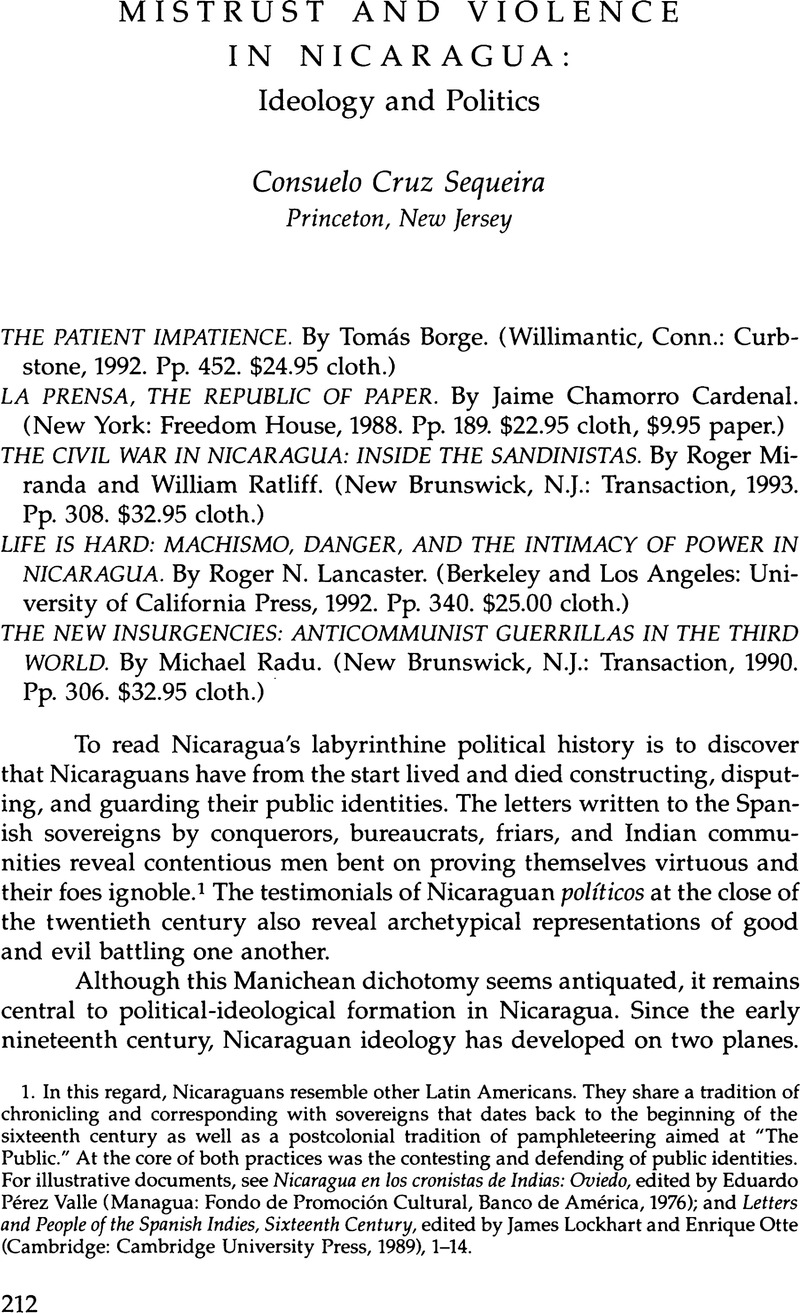Published online by Cambridge University Press: 05 October 2022

1. In this regard, Nicaraguans resemble other Latin Americans. They share a tradition of chronicling and corresponding with sovereigns that dates back to the beginning of the sixteenth century as well as a postcolonial tradition of pamphleteering aimed at “The Public.” At the core of both practices was the contesting and defending of public identities. For illustrative documents, see Nicaragua en los cronistas de Indias: Oviedo, edited by Eduardo Pérez Valle (Managua: Fondo de Promoción Cultural, Banco de América, 1976); and Letters and People of the Spanish Indies, Sixteenth Century, edited by James Lockhart and Enrique Otte (Cambridge: Cambridge University Press, 1989), 1–14.
2. Central Americans borrowed the appellations serviles and fievres from the political debate going on in Spain during the first decades of the nineteenth century between advocates of a constitutional monarchy and champions of unfettered kingly power. These terms were applied subsequently to participants in the Central American “debate” over annexation of the isthmus to Agustín de Iturbide's ephemeral Mexican empire. Finally, in postcolonial Central America, the labels survived from earlier debates, as families and localities split into camps based on their memory of one another's past stances.
3. Again, Nicaragua shares this tradition with other Latin American countries. In Argentina, for example, the tradition was exemplified by the pamphlets and newspapers put out by the “brutal tyrant” Juan Manuel de Rosas and by his foes, the “savage Unitarians.” For samples of Nicaraguan journalism in the nineteenth century, see Catálogo de la Exposición Treinta Años de Periodismo en Nicaragua, 1830–1860 (Managua: Instituto Centroamericano de Historia, Universidad Centroamericana, n.d.).
4. Illustrative of the Liberal variant is the biography of nineteenth-century Liberal caudillo Maximo Jerez by Sofonías Salvatierra, Máximo Jerez inmortal: comentario polémico (Managua: Tipografía Progreso, 1950). For a Conservative treatment of the same caudillo (and his foe, Conservative caudillo Fruto Chamorro), see Pedro Joaquín Chamorro, Máximo Jerez y sus contemporáneos (Managua: Editorial La Prensa, 1937). Again, this phenomenon extends throughout Latin America. For a fascinating overview of the Argentine manifestation, see Nicolás Shumway, The Invention of Argentina (Berkeley and Los Angeles: University of California Press, 1993).
5. The Liberals (or Democrats) were not the first to import foreign soldiers but were merely following an established tradition dating back to the first war after independence. For a succinct commentary on this point, see Salvatierra, Máximo Jerez, 70.
6. The triumvirate was composed of Fernando Aguero, a Conservative, and two Liberals beholden to Somoza, General Roberto Martínez and Alfonso Lobo Cordero. The triumvirate constituted the formal government at the time of the Managua earthquake, a national tragedy that Somoza treated as a business opportunity. Aguero objected vehemently to Somoza's interference in the management and finances of the reconstruction process. Somoza responded by entering into a tacit alliance with the dominant leaders of the Conservative party to remove Aguero from the government. Thus Aguero's last stand was also his first step into anonymity.
7. See Consuelo Cruz Sequeira, “The Political Culture of Order and Anarchy: Remembrance and Imaginative Power In Central America,” Ph.D. Dissertation, Massachusetts Institute of Technology, 1994.
8. Interpretation is meant here simply as “close reading” based on the incorporation of history and political culture, as opposed to a broader poststructuralist blurring of genres and disciplines. For a parsimonious discussion of the latter, see Jean Franco, “Remapping Culture,” in Americas: New Interpretative Essays, edited by Alfred Stepan (New York: Oxford University Press, 1992).
9. For a history in English of the civil war unleashed by these two notables, see Hubert Howe Bancroft, History of Central America, vol. 3, 1801–1887 (San Francisco, Calif.: The History Company, 1887); reprinted in The Works of Hubert Howe Bancroft, vol. 8 (New York: Arno and McGraw-Hill, 1960).
10. For collected primary documents in which this fear of rhetorical potency is articulated by Central Americans time and again, see various issues of Anales de la Sociedad de Geografía e Historia de Guatemala and Revista de la Academia de Geografía e Historia de Nicaragua.
11. Liberal caudillos have been some of the most accomplished gift-givers, most notably José Santos Zelaya (around the turn of the century) and all the Somozas.
12. In contrast to Lancaster's nuanced view of Nicaraguan popular culture, his view of Nicaragua's political history is rather simplistic. The little he has to say about it merely reiterates the leftist variant of the Manichean interpretations discussed in this essay. For example, Lancaster asserts, “Nicaragua's modern political history is a history of U.S. intervention, of political and economic dependency cultivated by Washington, and of sporadic, usually defeated rebellions against imperialism and exploitation” (p. 1).
13. Pierre Bourdieu, Outline of a Theory of Practice (New York: Cambridge University Press, 1991), 3–9.
14. Their anger is not feigned. Because men and women in Nicaragua cannot rely on a well-institutionalized, impartial judicial system to adjudicate their disputes and because they also lack the resources to take these disputes to court, they turn to the informal institutions available. These institutions are, a fortiori, culturally shaped.
15. Throughout most of the turbulent nineteenth century, no national state existed in Nicaragua, only fragile city-states that broke down every time a government collapsed. Governments fell when they proved unable to withstand armed opposition, leaving behind no structural or institutional legacy that might serve as the basis for ongoing state-building. In short, truncated governance was a consequence of sociopolitical instability and violent politics. Attempts at state development did not cause such instability and violence.